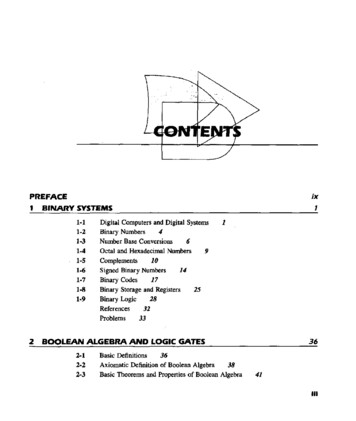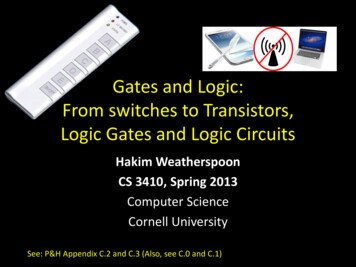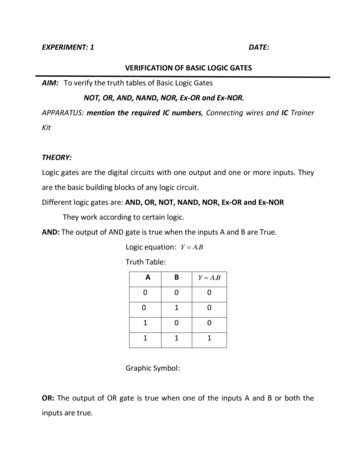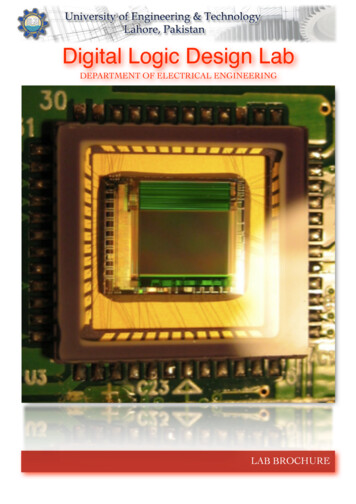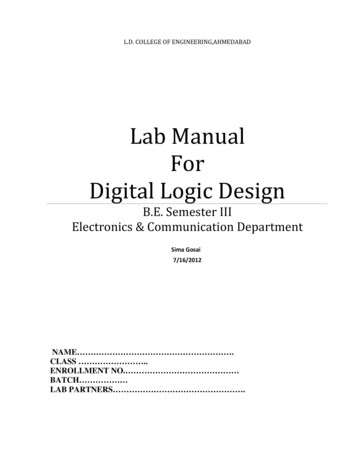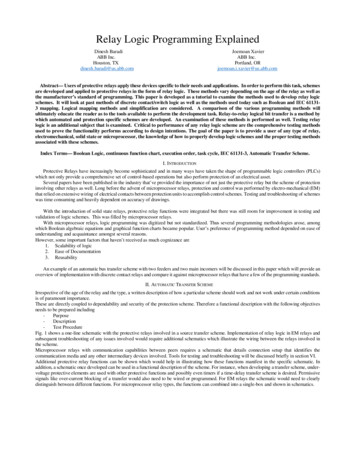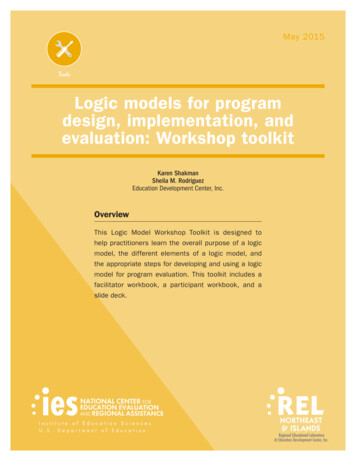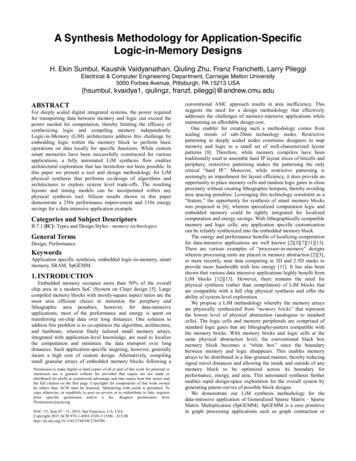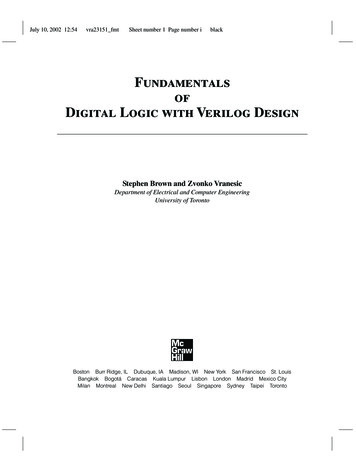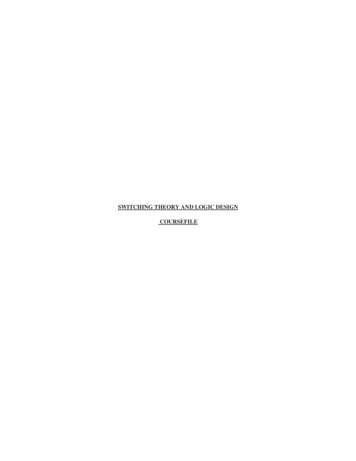
Transcription
SWITCHING THEORY AND LOGIC DESIGNCOURSEFILE
Coursefile contents:1. Cover Page2. Syllabus copy3. Vision of the department4. Mission of the department5. PEOs and POs6. Course objectives and outcomes7. Brief note on the importance of the course and how it fits in to the curriculum8. Prerequisites9. Instructional Learning Outcomes10.Course mapping with PEOs and POs11.Class Time Table12.Individual Time Table13.Lecture schedule with methodology being used/adopted14.Detailed notes15.Additional/missing topics16.University previous Question papers17. Question Bank18.Assignment topics19.Unit wise questions20.Tutorial problems21.Known gaps22.Discussion topics23.References, Journals, websites and E-links24. Quality measurement Sheetsa. course and surveyb. Teaching evaluation25. Student List26. GroupWise Student List for discussion topics
GEETHANJALI COLLEGE OF ENGINEERING AND TECHNOLOGYDEPARTMENT OF Electrical and Electronics Engineering(Name of the Subject / Lab Course) :Switching Theory and Logic Design(JNTU CODE –A40407)Programme : UGBranch: Electrical and Electronics EngineeringYear:Semester:II yearVersion No : 01Generated on : 05/11/15II-SemNo. of pages :Classification status (Unrestricted / Restricted )Distribution List :Prepared by : 1) Name : D.Radhika,2) Sign1) Name ::2) Sign :3) Design : Assoc. Prof3) Design :4) Date: 05/11/2015Verified by : 1) Name:2) Sign:4) Date :* For Q.C Only.1) Name :3) Design :2) Sign4) Date3) Design ::4) DateApproved by : (HOD )1) Name :2) Sign:3) Date:::
2. Syllabus copyJAWAHARLAL NEHRU TECHNOLOGIVAL UNIVERSITY HYDERABADII Year B.Tech. EEE –II SemL T/ P/ D C4 -/ - / 4SWITCHING THEORY AND LOGIC DESIGNUNIT INUMBER SYSTEMS AND BOOLEAN ALGEBRA AND SWITCHING FUNCTIONS: Numbersystems: Base Conversion Methods, Complement of Numbers, Codes - Binary codes, Binary CodedDecimal code and its properties, Unit distance codes, Alpha Numeric codes, Error detecting andcorrecting codes.Boolean Algebra: Basic theorems and propertiesSwitching Functions: Canonical and Standard forms, Algebraic simplification of digital logic gates,Properties of XOR gates , Universal gates, Multilevel NAND/NOR realizations.UNIT IIMINIMIZATION AND DEGIN OF COMBINATIONAL CIRCUITS: Introduction, TheMinimization with theorem, The Karnaugh Map Method, Five and Six variable Maps, Prime andEssential Implications, Don’t care Map entries, Using the maps for Simplifying, Tabular method, Partiallyspecified Expressions, Multi-Output Minimization, Minimization and combinational Design, ArithmeticCircuits, Comparator, Multiplexers, Code Converters, Wired Logic, Tristate Bus system, PracticalAspects related to Combinational Logic Design, Hazards and Hazard Free Relations.UNIT IIISEQUENCTIAL MACHINES FUNDAMENTALS: Introduction, Basic Architectural Distinctionsbetween Combinational and Sequential circuits, the Binary Cell, Fundamentals of Sequential MachineOperation, The Flip-Flop, The D- Latch Flip-Flop, the Clocked T Flip-Flop, the clocked J-K Flip-Flop,Design of a clocked Flip-flop, conversion from one Type of Flip-Flop to another, Timing and Triggeringconsiderations, Clock skew.UNIT IVSEQUENTIAL CIRCUITS DESIGN AND ANALYSIS: Introduction, State diagram, Analysis ofSynchronous Sequential Circuits, Approaches to the Design of Synchronous sequential Finite StateMachines, Design Aspects, State Reduction, Design Steps, Realization using Flip-Flops.Counters: Design Of Single Mode Counters; Ripple Counter, Ring Counter, Shift Register, ShiftRegister Sequences, Ring Counter using Shift Register.UNIT VSEQUENTIAL CIRCUITS : Finite state machine-capabilities and limitations, Mealy and Mooremodels-minimization of completely specified and incompletely specified sequential machines, Partitiontechniques and Merger chart methods-concept of minimal cover table.
ALGOROTHIMIC STATE MACHINES : Salient features of the ASM chart-Simple examples-Systemdesign using data path and control subsystems-control implementations-examples of Weighing machineand Binary multiplier.TEXT BOOKS :1. Switching & Finite Automata theory – Zvi Kohavi and Neeraj K Jha, ,3rd Edition, Cambridge.2. Digital Design – Morris Mano, PHI, 3rd Edition.REFERENCE BOOKS:1. Introduction to Switching Theory and Logic Design – Fredriac J Hill, Gerald R Peterson, 3rd Edition,John Willey and Sons Inc,2. Digital Fundamentals – A Systems approach – Thomas L Floyd, Pearson, 2013.3. Digital Logic Design – Ye Brian and HoldsWorth, Elsevier4. Fundamentals of Logic Design – Charles H. Roth, Thomson Publications, 5th Edition, 20045. Digital Logic Applications and Design – John M. Yarbrough, Thomson Publications, 20066. Digital logic and state machine design – Comer, 3rd, Oxford 2013.
3. Vision of EEETo provide excellent Electrical and electronics education by building strong teaching and research environment4. Mission of EEETo offer high quality graduate program in Electrical and Electronics education and to prepare students forprofessional career or higher studies. The department promotes excellence in teaching, research, collaborativeactivities and positive contributions to society
5.1 PROGRAM EDUCATIONAL OBJECTIVESPEO 1. Graduates will excel in professional career and/or higher education by acquiring knowledge inMathematics, Science, Engineering principles and Computational skills.PEO 2. Graduates will analyze real life problems, design Electrical systems appropriate to the requirement thatare technically sound, economically feasible and socially acceptable.PEO 3.Graduates will exhibit professionalism, ethical attitude, communication skills, team work in theirprofession, adapt to current trends by engaging in lifelong learning and participate in Research & Development.
5.2 PROGRAM OUTCOMESThe Program Outcomes of UG in Electrical and Electronics Engineering are as followsPO 1. An ability to apply the knowledge of Mathematics, Science and Engineering in Electrical andElectronics Engineering.PO 2. An ability to design and conduct experiments pertaining to Electrical and Electronics Engineering.PO 3. An ability to function in multidisciplinary teamsPO 4. An ability to simulate and determine the parameters such as nominal voltage current, power andassociated attributes.PO 5. An ability to identify, formulate and solve problems in the areas of Electrical and ElectronicsEngineering.PO 6. An ability to use appropriate network theorems to solve electrical engineering problems.PO 7. An ability to communicate effectively.PO 8. An ability to visualize the impact of electrical engineering solutions in global, economic and societalcontext.PO 9. Recognition of the need and an ability to engage in life-long learning.PO 10 An ability to understand contemporary issues related to alternate energy sources.PO 11 An ability to use the techniques, skills and modern engineering tools necessary for ElectricalEngineering Practice.PO 12 An ability to simulate and determine the parameters like voltage profile and current ratings oftransmission lines in Power Systems.PO 13 An ability to understand and determine the performance of electrical machines namely speed, torque,efficiency etc.PO 14 An ability to apply electrical engineering and management principles to Power Projects.
6.1 COURSE OBJECTIVESS.NoObjectives1To learn basic tools for the design of digital circuits and fundamental concepts used in the design of digital systems2To Understand common forms of number representation in digital electronic circuits and to be able to convertbetween different representations.To implement simple logical operations using combinational logic circuits34To design combinational logic circuits, sequential logic circuits5To impart to student the concepts of sequential circuits, enabling them to analyze sequential systems interms of statemachines.6To implement synchronous state machines using flip flops.6.2 COURSE OUTCOMESS.No.1234OutcomeAble to manipulate numeric information in different forms, e.g. different bases, signed integers, variouscodes such as ASCII, gray, and BCD.Able to manipulate simple Boolean expressions using the theorems and postulates of Boolean algebra andto minimize combinational functions.Able to design and analyze small combinational circuits and to use standard combinationalfunctions/building blocks to build larger more complex circuits.Able to design and analyze small sequential circuits and devices and to use standard sequentialfunctions/building blocks to build larger more complex circuits.7. BRIEF NOTE ON THE IMPORTANE OF THE COURSE:a. This Course provides in-depth knowledge of switching theory and design techniques of digitalcircuits, which is the basis for design of any digital circuit.b. This subject is required to understand the later subjects like LDICA, MPMC, VLSI& ES, etc.c. By studying this subject, the students can design and understand digital systems and itsimportance.d. The students logical thinking capability will be improved which will help in placements and intheir future technical assignments.
8. PREREQUISITES:1. Set theory (Mathematics)2. Basic logic operations like bit wise operations, Shift operations, flow charts, ASCII codes, etc.(Computer Programming)9. INSTRUCTIONAL LEARNING OUTCOMESUNIT-ISlNo.123ModuleNumber System andBoolean Algebra andSwitching Functions45SlNo.1Module234Minimization and Designof Combinational Circuits5SlNo.1Module2Sequential machinesfundamentals34SlNo.1234ModuleSequential circuit designand analysisOutcomesAble to Know different number systemsAble to do Conversion Operations between differentnumber systemsAble to know basic theorems and properties used inBoolean algebraDesigns different logic circuits using different logicgatesDesigns multilevel realization functionsUNIT-IIOutcomesAble to get basic information in the design ofcombinational circuitsAble to solve and analyze Karnaugh MapsDesigns Combinational multi level circuitsAble to know the operation of Multiplexers and otherarithmetic circuitsCan perform practical’s with combinational logiccircuitsUNIT-IIIOutcomesAble to identify architectural differences incombinational and sequential circuitsAble to design sequential circuits for machineoperationAble to design Clocked flip flopsMakes use of timing and triggering circuits withsequential logicsUNIT-IVOutcomesAble to draw state diagramsAble to analyze synchronous sequential circuitsDesigns sequential finite state machinesDesigns different types of counters and registers
UNIT-VSlNo.1ModuleOutcomesAble to identify capabilities and limitations of finitestate machineAble to know Mealy and Moore minimizationmodelsAble to know partition techniques and merger chartmethodsAble to know about concept of minimal cover tableAble to design any system using data path andcontrols subsystemsKnows the control logics of weighing machine andbinary multiplier2Sequential circuits andalgorithmic state machines345610. Course mapping with PEOs and POsMapping of Course with Programme Educational icscourseSemester PEO 1STLDPEO 2 IIPEO 3 Mapping of Course outcomes with Programme outcomes:*When the course outcome weightage is 40%, it will be given as moderately correlated (1).*When the course outcome weightage is 40%, it will be given as strongly correlated (2).POsSTLDCO 1:1222223224115226789111011112212221322Number Systems,Codes and theirConversions.b. Explain ErrorDetecting & ErrorCorrecting Codesc. Solve typicalproblems on the above.Digital Systemsa. Explain different
CO t the givenBoolean / Switchingfunctions in variousforms, prove BooleanTheorems, andminimize Booleanfunctions using theseTheorems. RealizeSwitching functionsusing basic logicgates/universal gates.CO 3:a. Minimize the givenSwitching functions inSoP and PoS formsusing K-Map.b. Given a switching afunction, generate theset of Prime Implicantsusing Tabular Methodandminimizethefunction.CO 4:Design the differenttypes of combinationallogic circuits.CO 5:Design combinationallogic circuits usingdifferent types of PLDs,
namely, PROM, PLAand PAL.CO 6:222121122222212112222211222Design different typesof synchronoussequential logiccircuits.CO 7:Design fundamentalmode and pulse modeasynchronoussequential machines.CO 8:22Design digital systemsusing ASM Charts.Geethanjali College of Engineering & TechnologyDepartment of Electrical & Electronics EngineeringYear/Sem/Sec:II-B. Tech-II Sem(Version-0)Room No:Acad Year 2015-16,WEF: 07-12-2015Class Teacher: ARY/MENTORINGMEFACRTLUNCHTimeMEFAEM-IIECECS/EM-I LABECS/EM-I LABMEFAECPS-IGENDER SENSITIZATIONSubject(T/P)Faculty Name1Mobile NoPeriods/WeekNetwork Theory (A40213)Dr.S.Radhika4 1*-Periods2Switching Theory and Logic Design(A40407)Mrs.D.Radhika4 1*-Periods3Electrical Machines-II (A40212)Mr.G.Srikanth/Mrs.D.Radhika4 1*-Periods4Power Systems-I (A40214)Mr.N.Santhinath4 1*-Periods5Manegerial Eeconomics and FinancialMrs.B.P.S.Jyothi4-Periods
Analysis (A40010)6Electronic Circuits (A40413)Mrs.B.Mamatha7GENDER SENSITIZATIONMr.N.V.Bharadwaj8Electrical Machines-I LAB ctrical Circuits and Simulation /LIBRARY/SPORTS/MENTORING11Campus Recruitment Training4 1*-Periods3-Periods3 3-Periods3 3Periods2PERIODS2Periods*- TutorialDate: 3/12/2015Dept. Coord:HOD: DeanAcad: Principal:13. Lecture schedule with methodology being used / adoptedWeekNo.Topic to be coveredin One lectureRegular/AdditionalTeaching aidsusedLCD/OHP/BBWEEK 1Introduction to switchingtheory and logic designRegularBB2Number SystemsRegularBB3Number base conversionsRegularBB4Complement of numbersRegularBBBinary Codes, BinaryCoded Decimal Code and itspropertiesRegularBBUnit Distance Codes, AlphaNumeric CodesRegularBB7Error Detecting &correcting codesRegularBB8Tutorial classRegularBB8Fundamental & postulatesof Boolean algebraRegularBB9Theorems and propertiesRegularBBSwitching functionsRegularBBSL.No.UnitNo.1ITotalNo. ofPeriodsTUTORIAL5610WEEK 2WEEK 3Remarks
11Canonical & standard formsRegularBBTUTORIAL12Algebraic simplification ofdigital logic gatesRegularBB13Inhibit circuitsAdditionalBB16Propertiesof XOR Gates,Universal Gates1718WEEK 4IIBBMulti-level NAND/NORRealizationsRegularBBMinimization with theoremsRegularBBTUTORIAL19k-Map MethodRegularBB20Five and Six variable MapsRegularBB21Prime and Essential PrimeImplications, Don’t CareMap EntriesRegularBBTabular MethodRegularBB22WEEK 5TUTORIAL23Partially SpecifiedExpressionsRegularBB24Multi-output MinimizationRegularBB25Combinational Design:Arithmetic RegularBBCode ConvertersRegularBB2728WEEK 6TUTORIAL29Wired Logic, Tri-state BusSystemsAdditionalBB30Practical Aspects related tocombinational Logic designRegularBB
31TUTORIALRegularBBSequential MachineFundamentals - introductionRegularBB33Basic architecturaldistinctions betweencombinational andsequential circuitsRegularBB34Binary Cell, fundamentalsof sequential machineoperationRegularBB35Flip-flop and types of flipflopsRegularBB36D- Latch K 7III37WEEK arBB45AdditionalBB42WEEK 946BB47B.TECH I-MIDINTERNALEXAMINATIONS4849WEEK 10VRegularBB50RegularBB51RegularBB52RegularBB
53WEEK 11(15TH SEPTO arBB59RegularBB60AdditionalBB58WEEK 1261BB62BB6314. Detailed NotesDigital and Analog SignalsSignals carry information and are defined as any physical quantity that varies with time, space, or any otherindependent variable. For example, a sine wave whose amplitude varies with respect to time or the motion of aparticle with respect to space can be considered as signals. A system can be defined as a physical device thatperforms an operation on a signal. For example, an amplifier is used to amplify the input signal amplitude. In thiscase, the amplifier performs some operation(s) on the signal, which has the effect of increasing the amplitude of thedesired information-bearing signal.Signals can be categorized in various ways; for example discrete and continuous time domains. Discrete-timesignals are defined only on a discrete set of times. Continuous-time signals are often referred to as continuoussignals even when the signal functions are not continuous; an example is a square-wave signal.Figure 1a: Analog SignalFigure 1b : Digital SignalAnother category of signals is discrete-valued and continuous-valued or otherwise known as digital and analog signals.Digital signals are discrete-valued and analog signals are continuous electrical signals that vary in time as shown in Figure1 (a) and (b). Analog devices and systems process signals whose voltages or other quantities vary in a continuous manner.
They can take on any value across a continuous range of voltage, current, or other metric. The analog signals can have aninfinite number of values. Analog systems can be called wave systems. They have a value that changes steadily over timeand can have any one of an infinite set of values in a range. Analog signals represent some physical quantity and they canbe a model of the real quantity. Most of the time, the variations corresponds to that of the non-electric (original) signal.For example, the telephone transmitter converts the sounds into an electrical voltage signal. The intensity of the voicecauses electric current variations. Therefore, the two are analogous hence the name analog. At the receiving end, thesignal is reproduced in the same proportion. Hence the electric current is a model and is an electrical representation ofone's voice.Not all analog signals vary as smoothly as the waveform shown in Fig 1(a). Digital signals are non-continuous, theychange in individual steps. They consist of pulses or digits with discrete levels or values. The value of each pulse isconstant, but there is an abrupt change from one digit to the next. Digital signals have two amplitude levels. The value ofwhich are specified as one of two possibilities such as 1 or 0, HIGH or LOW , TRUE or FALSE and so on. In reality, thevalues are anywhere within specific ranges and we define values within a given range.A digital system is the one that handles only discrete values or signals. Any set that is restricted to a finite number ofelements contains discrete information. The word digital describes any system based on discontinuous data or events.Digital is the method of storing, processing and transmitting information through the use of distinct electronic pulses thatrepresent the binary digits 0 and 1. Examples of discrete sets are the 10 decimal digits, the 26 letters of the alphabet etc. Adigital system would be to flick the light switch on and off. There's no 'in between' values.Advantages of digital signalsThe usual advantages of digital circuits when compared to analog circuits are:Noise Margin (resistance to noise/robustness) : Digital circuits are less affected by noise. If the noise is below a certainlevel (the noise margin), a digital circuit behaves as if there was no noise at all. The stream of bits can be reconstructedinto a perfect replica of the original source. However, if the noise exceeds this level, the digital circuit cannot give correctresults.Error Correction and Detection : Digital signals can be regenerated to achieve lossless data transmission, within certainlimits. Analog signal transmission and processing, by contrast, always introduces noise.Easily Programmable : Digital systems interface well with computers and are easy to control with software. It is oftenpossible to add new features to a digital system without changing hardware, and to do this remotely, just by uploadingnew software. Design errors or bugs can be worked-around with a software upgrade, after the product is in customerhands. A digital system is often preferred because of (re-)programmability and ease of upgrading without requiringhardware changes.Cheap Electronic Circuits : More digital circuitry can be fabricated per square millimeter of integrated-circuit material.Information storage can be much easier in digital systems than in analog ones. In particular, the great noise-immunity ofdigital systems makes it possible to store data and retrieve it later without degradation. In an analog system, aging andwear and tear will degrade the information in storage, but in a digital system, as long as the wear and tear is below acertain level, the information can be recovered perfectly. Theoretically, there is no data-loss when copying digital data.This is a great advantage over analog systems, which faithfully reproduce every bit of noise that makes its way into thesignal.Disadvantages The world in which we live is analog, and signals from this world such as light, temperature, sound,electrical conductivity, electric and magnetic fields, and phenomena such as the flow of time, are for most practicalpurposes continuous and thus analog quantities rather than discrete digital ones. For a digital system to do useful things inthe real world, translation from the continuous realm to the discrete digital realm must occur, resulting in quantizationerrors. This problem can usually be mitigated by designing the system to store enough digital data to represent the signalto the desired degree of fidelity. The Nyquist-Shannon sampling theorem provides an important guideline as to how muchdigital data is needed to accurately portray a given analog signal.Digital systems can be fragile, in that if a single piece of digital data is lost or misinterpreted, the meaning of large blocksof related data can completely change. This problem can be diminished by designing the digital system for robustness. Forexample, a parity bit or other error-detecting or error-correcting code can be inserted into the signal path so that minordata corruptions can be detected and possibly corrected.Digital circuits use more energy than analog circuits to accomplish the same calculations and signal processing tasks, thusproducing more heat as well. In portable or battery-powered systems this can be a major limiting factor.Digital circuits are made from analog components, and care has to be taken to all noise and timing margins, to parasiticinductances and capacitances, to proper filtering of power and ground connections, to electromagnetic coupling amongstdata lines. Inattention to these can cause problems such as "glitches", pulses do not reach valid switching (threshold)voltages, or unexpected ("undecoded") combinations of logic states.A corollary of the fact that digital circuits are made from analog components is the fact that digital circuits are slower toperform calculations than analog circuits that occupy a similar amount of physical space and consume the same amount ofpower. However, the digital circuit will perform the calculation with much better repeatability, due to the high noiseimmunity of digital circuitry.Number Systems
IntroductionNumber systems provide the basis for all operations in information processing systems. In a number system theinformation is divided into a group of symbols; for example, 26 English letters, 10 decimal digits etc. In conventionalarithmetic, a number system based upon ten units (0 to 9) is used. However, arithmetic and logic circuits used incomputers and other digital systems operate with only 0's and 1's because it is very difficult to design circuits that requireten distinct states. The number system with the basic symbols 0 and 1 is called binary. ie. A binary system uses just twodiscrete values. The binary digit (either 0 or 1) is called a bit.A group of bits which is used to represent the discrete elements of information is a symbol. The mapping of symbols to abinary value is known a binary code. This mapping must be unique. For example, the decimal digits 0 through 9 arerepresented in a digital system with a code of four bits. Thus a digital system is a system that manipulates discreteelements of information that is represented internally in binary form.Decimal NumbersThe invention of decimal number system has been the most important factor in the development of science andtechnology. The decimal number system uses positional number representation, which means that the value of each digitis determined by its position in a number.The base, also called the radix of a number system is the number of symbols that the system contains. The decimal systemhas ten symbols: 0,1,2,3,4,5,6,7,8,9. In other words, it has a base of 10. Each position in the decimal system is 10 timesmore significant than the previous position. The numeric value of a decimal number is determined by multiplying eachdigit of the number by the value of the position in which the digit appears and then adding the products. Thus the number2734 is interpreted asHere 4 is the least significant digit (LSD) and 2 is the most significant digit (MSD).In general in a number system with a base or radix r, the digits used are from 0 to r-1 and the number can be representedasEquation (1) is for all integers and for the fractions (numbers between 0 and 1), the following equation holds.Thus for decimal fraction 0.7123Binary NumbersThe binary number has a radix of 2. As r 2, only two digits are needed, and these are 0 and 1. Like the decimal system,binary is a positional system, except that each bit position corresponds to a power of 2 instead of a power of 10. In digitalsystems, the binary number system and other number systems closely related to it are used almost exclusively. Hence,digital systems often provide conversion between decimal and binary numbers. The decimal value of a binary number canbe formed by multiplying each power of 2 by either 1 or 0 followed by adding the values together.Example : The decimal equivalent of the binary number 101010.In binary r bits can representsymbols. e.g. 3 bits can represent up to 8 symbols, 4 bits for 16 symbols etc. For Nsymbols to be represented, the minimum number of bits required is the lowest integer 'r'' that satisfies the relationship.e.g. if N 26, minimum r is 5 since.Octal NumbersDigital systems operate only on binary numbers. Since binary numbers are often very long, two shorthand notations, octaland hexadecimal, are used for representing large binary numbers. Octal systems use a base or radix of 8. Thus it has digitsfrom 0 to 7 (r-1). As in the decimal and binary systems, the positional valued of each digit in a sequence of numbers is
fixed. Each position in an octal number is a power of 8, and each position is 8 times more significant than the previousposition.Example : The decimal equivalent of the octal number 15.2.Hexadecimal NumbersThe hexadecimal numbering system has a base of 16. There are 16 symbols. The decimal digits 0 to 9 are used as the firstten digits as in the decimal system, followed by the letters A, B, C, D, E and F, which represent the values 10, 11,12,13,14and 15 respectively. Table 1 shows the relationship between decimal, binary, octal and hexadecimal number systems.Decimal Binary Octal B12110014C13110115D14111016E15111117FHexadecimal numbers are often used in describing the data in computer memory. A computer memory stores a largenumber of words, each of which is a standard size collection of bits. An 8-bit word is known as a Byte. A hexadecimaldigit may be considered as half of a byte. Two hexadecimal digits constitute one byte, the rightmost 4 bits correspondingto half a byte, and the leftmost 4 bits corresponding to the other half of the byte. Often a half-byte is called nibble.If "word" size is n bits there are 2n possible bit patterns so only 2n possible distinct numbers can be represented. Itimplies that all possible numbers cannot be represent and some of these bit patterns (half?) to represent negative numbers.The negative numbers are generally represented with sign magnitude i.e. reserve one bit for the sign and the rest of bitsare interpreted directly as the number. For example in a 4 bit system, 0000 to 0111 can be used to positive numbers from 0 to 2n-1 and represent 1000 to 1111 can be used for negative numbers from -0 to -2n-1. The two possible zero'sredundant and also it can be seen that such representations are arithmetically costly.Another way to represent negative numbers are by radix and radix-1 complement (also called r's and (r-1)'s). For example-k is represented as Rn -k. In the case of base 10 and corresponding 10's complement with n 2, 0 to 99 are the possiblenumbers. In such a system, 0 to 49 is reserved for positive numbers and 50 to 99 are for positive numbers.Examples: 3 3-3 10 2 -3 972's complement is a special case of complement representation. The negative number -k is equal to 2 n -k. In 4 bitssystem, positive numbers 0 to 2n-1 is represented by 0000 to 0111 and negative numbers -2n-1 to -1 is represented by 1000to 1111. Such a representation has only one zero and arithmetic is easier. To negate a number complement all bits and add1Example:119 10 01110111 2Complementing bits will result
10001000 1add10001001That is 10001001 2 - 119 101Properties of Two's Complement Numbers1.X plus the complement of X equals 0.2.There is one unique 0.3.Positive numbers have 0 as their leading bit ( MSB ); while negatives have 1 as their MSB .4.The range for an n-bit binary number in 2's complement representation is from -2 (n-1) to 2 (n-1) - 15.The complement of the complement of a number is the original number.6.Subtraction is done by addition to the 2's complement of the number.Value of Two's Complement NumbersFor a
3. Digital Logic Design – Ye Brian and HoldsWorth, Elsevier 4. Fundamentals of Logic Design – Charles H. Roth, Thomson Publications, 5th Edition, 2004 5. Digital Logic Applications and Design – John M. Yarbrough, Thomson Publications, 2006 6. Digital logic and state m

